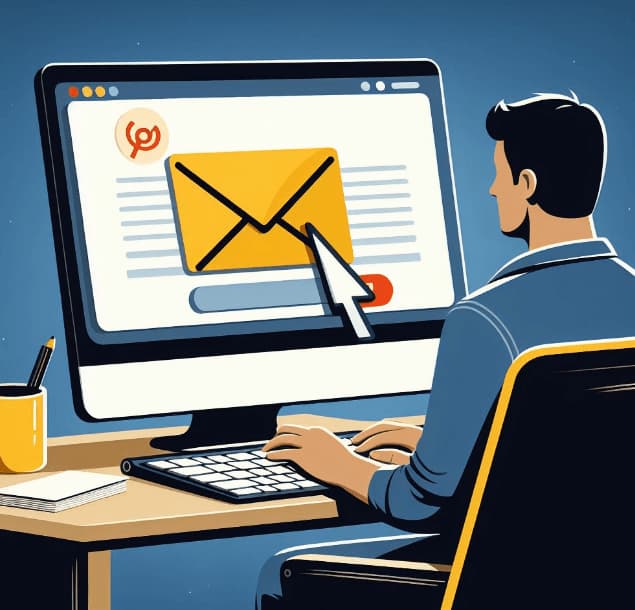Selecting the right Email Service Provider (ESP) is paramount for businesses seeking to optimize their email marketing strategies. With a multitude of options available, navigating this complex terrain can be overwhelming. That’s why MX Layer experts have crafted this simple guide to help businesses overcome the challenges and seize the opportunities associated with switching ESPs.
Choosing the ideal ESP entails finding a provider that seamlessly integrates with existing systems, enhances efficiency, and prioritizes security. However, sticking with an ESP that falls short of meeting these criteria can hinder a business’s growth and effectiveness in reaching its target audience. This guide provides actionable insights to ensure a smooth transition and maximize the benefits of a new ESP. Let’s now delve into the reasons that may prompt a transition.
What are the Reasons to Switch ESPs?

Businesses need to stay agile and adaptable. One such area of adaptability is the choice of ESP. While your current ESP might have served you well in the past, various factors could lead you to consider switching. These reasons range from technical issues to service-related concerns. Let’s delve into these reasons in more detail:
-
Lack of Email Security
If your current ESP lacks potent email security measures, including encryption, phishing detection, and anti-malware protocols, it poses a significant risk to your business and your subscribers. A breach in email security can lead to compromised sensitive information, damaged reputation, and legal ramifications. Switching to an ESP that prioritizes and invests in robust email security can protect your business and instill trust among your subscribers.
Leveraging services like MX Layer can enhance email security regardless of the physical location of your ESP’s servers. MX Layer provides a layer of protection that helps secure email environments by filtering out malicious content, detecting and blocking threats, and ensuring compliance with industry regulations. By integrating MX Layer with your chosen ESP, you can strengthen your email security posture and mitigate risks effectively.
-
Poor Email Deliverability
If your current ESP is failing to deliver satisfactory rates, it might be time to consider a switch. Factors such as sender reputation, lack of email authentication, or being blacklisted can significantly impact deliverability. Even a slight improvement in deliverability rates can translate to substantial gains for your business.
-
Slow Response Time to Support Questions
Timely support is crucial for resolving issues efficiently and maintaining operational effectiveness. If your ESP is lacking in providing prompt and effective support, it could lead to delays and inefficiencies in your campaigns. Consider switching to a provider that prioritizes customer service and ensures timely responses to support queries.
-
Lack of a Dedicated Account Manager
A dedicated account manager can offer personalized service and strategic guidance tailored to your business objectives. If your current ESP doesn’t provide a dedicated account manager, you might be missing out on valuable insights and support. Switching to a provider that offers this service can enhance the effectiveness of your email marketing efforts.
-
Missing Modern Functionalities
As email marketing evolves, so do the essential tools and features offered by ESPs. Advanced functionalities such as analytics, automation, and list management are vital for a modern email marketing strategy. If your current ESP lacks these features, it may hinder your ability to stay competitive.
-
Growing Contact List
As your business expands, your contact list grows accordingly. If your current ESP struggles to handle the increasing volume of emails efficiently, it’s a clear sign that you need to switch to a provider that can scale with your business needs.
-
New Budget or Need for New Features
Changes in budget or the need for advanced features can also prompt a switch in ESPs. Whether your budget fluctuates or you need new features to remain competitive, finding an ESP that aligns with your current needs and future goals is crucial.
-
Re-Evaluating Current Sending Processes
Switching ESPs presents an opportunity to re-evaluate your current sending processes and implement improvements to enhance deliverability and campaign effectiveness. Take advantage of this opportunity to optimize your email marketing strategy and achieve better results.
Having understood the reasons behind contemplating a shift in ESPs, let’s now address how to effectively tackle the challenges that come with making such a transition.
Overcome Challenges in Switching ESPs
Switching ESPs can present various fears and challenges for organizations, each with its unique set of considerations. While some common hurdles have been highlighted, additional challenges may arise during the transition process.
Fears and Challenges
- Choice Overload: The abundance of ESP options can overwhelm decision-makers. To navigate this challenge, prioritize understanding your organization’s unique needs, goals, and email marketing strategy.
- Feature Deficiency: Outdated or inadequate features in your current ESP can hinder your marketing efforts.
- Data Migration: Migrating data between ESPs demands attention to detail to avoid data loss or compromise. Ensure seamless transition by transferring crucial data, including contacts’ subscription statuses, unsubscribed or bounced email addresses, and consent management information.
- Consent Management: Respect audience consent by confirming their willingness to receive your communications. Sending irrelevant offers or poorly timed messages can make people unhappy and cause them to withdraw their consent.
- Unsubscribed Contacts: Prevent inadvertent communication with unsubscribed contacts by updating recipient lists. Opt out of previously unsubscribed contacts from your new ESP to uphold compliance and maintain the sender’s reputation.
- Data Hygiene: Prioritize data cleanliness through comprehensive list cleanings before initiating any email campaigns. Prioritizing data cleanliness ensures that your recipient lists are accurate, up-to-date, and free from invalid or outdated entries.
- Deadline Pressure: Avoid compromising delivery results by succumbing to tight deadlines. Prioritize achieving desired delivery outcomes over meeting arbitrary timelines to uphold the quality and effectiveness of your email campaigns.
Tips to Expedite the Switch and Avoid Mistakes

- Start Early: Initiate the migration process well in advance to allow ample time for thorough planning, execution, and troubleshooting. Beginning early mitigates the risks of last-minute complications and facilitates a smoother transition.
- Don’t Rush: Resist the temptation to rush through the migration process. Prioritize precision and accuracy over speed to minimize the likelihood of costly errors and disruptions to your email operations.
- Clean Up Your Data: Leverage the transition period to cleanse and refine your contact data. Ensure compliance with consent regulations and target only engaged recipients who are genuinely interested in your offerings.
- Maintain Continuity: Preserve brand consistency and messaging coherence by retaining your domain and content branding elements. Deliver targeted messages with clear calls to action to sustain audience engagement and loyalty.
- Prioritize Delivery: Optimize email delivery by focusing on engaged recipients who are more likely to interact with your content. Prioritizing delivery to this segment enhances deliverability rates and maximizes campaign effectiveness.
- Authenticate Your Emails: Protect your email deliverability and reputation by ensuring proper authentication of your emails. Verify DNS records and authentication protocols to prevent potential deliverability issues and maintain sender credibility.
- Reach Out for Help: Don’t hesitate to seek guidance or assistance from experts or support resources if you encounter challenges during the transition. Leveraging external expertise can provide valuable insights and resolutions to overcome obstacles effectively.
Key Features to Look for in a New Email Service Provider (ESP)
When considering a new Email Service Provider (ESP), it’s crucial to prioritize certain features that can significantly elevate your email marketing endeavors. Here are some of the most essential features to look for:
- Robust Analytics: The ability to track metrics and benchmarks for your email campaigns is paramount for refining future marketing strategies. Seek an ESP with an intuitive analytics dashboard that offers clear and visually appealing insights into campaign performance.
- Marketing Automation Capabilities: Automation can be a game-changer, enabling you to save time and enhance efficiency in your email marketing efforts. Your chosen ESP should provide robust automation tools that allow for tasks such as scheduling emails at specified times or triggering responses based on subscriber actions.
- List Management: Effective list management is key to maintaining a healthy subscriber base and optimizing engagement. Look for an ESP that simplifies the process of cleaning and organizing email lists, offering features like segmentation to target specific groups within your audience.
- High Deliverability Rates: Ensuring that your emails reliably land in subscribers’ inboxes is fundamental to the success of your campaigns. Choose an ESP with a proven track record of maintaining high deliverability rates, achieved through adherence to best practices and compliance with industry standards.
- Ease of Use: An intuitive platform with user-friendly features can streamline the email campaign creation process and minimize learning curves. Prioritize an ESP that offers a seamless user experience, enabling you to easily create and deploy campaigns.
- Collaboration: Collaboration is increasingly important in email marketing, with multiple team members often involved in campaign reviews and approvals. Seek an ESP that facilitates seamless collaboration among team members, allowing for efficient communication and feedback exchange.
- Customer Support: Transitioning to a new ESP can be complex, and having reliable customer support is essential for overcoming challenges and maximizing the platform’s potential. Choose an ESP that offers responsive and knowledgeable customer support services to assist you throughout the migration process and beyond.
Checklist for Transitioning to a New ESP

A well-structured checklist, like the one we have provided here serves as a roadmap for businesses during this transition. It ensures that all critical aspects, from assessing current needs, researching potential ESPs, evaluating data migration processes to monitoring and optimizing performance, are thoroughly considered. So, whether you’re a small business or a large corporation, this checklist can be a valuable tool in your ESP transition journey.
| Checklist Item | Description |
| Assess Current Needs and Pain Points |
|
| Research Potential ESPs |
|
| Evaluate Data Migration Process |
|
| Review Email Deliverability |
|
| Assess Customer Support |
|
| Consider Integration Capabilities |
|
| Review Security Measures |
|
| Analyze Reporting and Analytics |
|
| Consider Contract Terms and Pricing |
|
| Perform a Trial or Demo |
|
| Plan for Transition and Training |
|
| Monitor and Optimize Performance |
|
The Switching Process

Switching ESPs can be a smooth transition. While the exact steps may vary depending on the ESPs involved, we’ve compiled a general guide to help you navigate this process.
- Sign Up with the New Provider: Begin by signing up with your new ESP. Ensure you set up your new web hosting account and pay all necessary fees.
- Configure Your Domain Name: Next, configure your domain name with the new provider. This step is crucial for ensuring your emails are correctly associated with your domain.
- Import Old Emails & Contacts: Many ESPs offer import functions that automatically bring in existing emails and contacts from your old email account. This function consolidates your emails in one place and makes them easily searchable.
- Create the Same Email Address on the New Server: It’s crucial to recreate the same email address on the new server to ensure continuity and prevent missing any emails sent to your old address.
- Redirect Your Domain Name: Redirect your domain name to point it to the new server, ensuring that all emails sent to your domain are now routed to your new ESP.
- Configure Your Email Tool: Set up your email tool to send and receive emails using the new server. Whether you’re using your old email tool or a new one provided by your new ESP, ensure you configure it correctly.
- Set Up Email Fetching or Forwarding: Consider setting up email fetching or forwarding. This feature automatically directs new emails sent to your old email address to appear in your new email inbox, streamlining the transition process.
- Clean Up the Old Server: Finally, clean up the old server by deleting any unnecessary data and closing the account if it’s no longer needed.
 In conclusion, transitioning to a new ESP is a strategic decision that requires careful planning and execution to ensure a seamless shift while maximizing the benefits for your business. This comprehensive guide provided by MX Layer experts highlights the key reasons for considering a switch, ranging from poor deliverability and inadequate support to the need for modern functionalities and evolving business requirements. With a focus on selecting an ESP that aligns with your organization’s goals, offers essential features such as robust analytics and marketing automation, and provides reliable customer support, businesses can optimize their email marketing strategies and propel growth in today’s competitive landscape.
In conclusion, transitioning to a new ESP is a strategic decision that requires careful planning and execution to ensure a seamless shift while maximizing the benefits for your business. This comprehensive guide provided by MX Layer experts highlights the key reasons for considering a switch, ranging from poor deliverability and inadequate support to the need for modern functionalities and evolving business requirements. With a focus on selecting an ESP that aligns with your organization’s goals, offers essential features such as robust analytics and marketing automation, and provides reliable customer support, businesses can optimize their email marketing strategies and propel growth in today’s competitive landscape.






